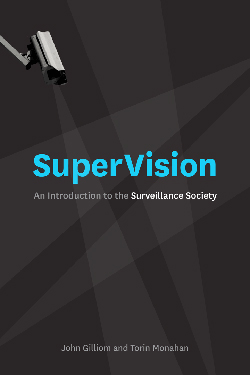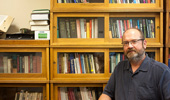 Just as the dialogue on border security and immigration heats up—and as police departments bring drones from the battlefield to the neighborhood, Ohio University’s John Gilliom and co-author Torin Monahan of the University of North Carolina take a close look at the surveillance society in their new book SuperVision.
Just as the dialogue on border security and immigration heats up—and as police departments bring drones from the battlefield to the neighborhood, Ohio University’s John Gilliom and co-author Torin Monahan of the University of North Carolina take a close look at the surveillance society in their new book SuperVision.
Among their topics: technology that bring Superman-like vision from the battlefield and the border to the backyard and beyond.
“A few years back, the big excitement was about police cruiser cameras … and red-light cameras,” write the authors. Now, “it might sound like science fiction, but ‘smart surveillance’ and ‘automated prediction’ are upon us.” SuperVision: an Introduction to the Surveillance Society, was published by the University of Chicago Press. Gilliom is a Professor of Political Science and Associate Dean in the College of Arts and Sciences at Ohio University.
“For those who take comfort in the idea that your phone calls, Facebook posts, and Google searches are safely separated from the prying eyes of government agents, think again. The public-private partnership in surveillance is strong, will continue to grow, and is very well-hidden from any meaningful accountability,” write Gilliom and Manahan.
“When video surveillance is mediated by computer algorithms…it will be easier to compile detailed representations of people’s movements, locations, interactions, and social networks….And there’s more. Computer scientists have already devised a way to erase people or objects from video feeds in real time.” From North Carolina to Houston to Las Vegas, drones are already being used to monitor large gatherings and assist in investigations, i.e. to “keep watch” on citizens, note the authors. The national security dialogue also has focused recently on the appropriate use of drones overseas.
“The increase in drone surveillance raises a number of important questions. Is it ethical to use these systems to kill others, particularly when drones seem prone to collateral damage? Do we really want silent, almost invisible technologies of war hovering over our cities, scrutinizing our every move? Will they be used in prejudicial ways to monitor activists or others engaged in lawful activities? How safe are they from an aviation perspective? Will they cause airplane crashes or fall into our homes or playgrounds when they malfunction? As with most surveillance systems, questions of this sort are not currently a part of mainstream public discourse, but they absolutely should be.”
On border surveillance, the authors describe:
- A massive human surveillance force, “with video cameras, drug-sniffing dogs, RFID scanners for pre-cleared vehicles, and even unmanned aerial drones.”
- A high-tech system of thermal sensors, motion detectors and video cameras that covers only 53 miles instead of the planned 2,000.
- Citizens watching the border via passive webcams or active surveillance, with the ACLU and humanitarian organizations watching the watchers.
- Drones that “have become a staple of border security.”
“People want to be protected from harm,” note the authors. “Violent crime and terrorism rank high on the list of things we’d all like to avoid. So it makes sense on one level that the promise of protection through surveillance would be appealing. Unfortunately, study after study shows that technological surveillance is not very good at preventing crime and is probably even less effective at preventing terrorism.”
Several online media have been writing about the workplace surveillance issues discussed in SuperVision:
- The article Work becomes more like prison at Salon on Feb. 19 notes: “In SuperVision: An Introduction to the Surveillance Society, John Gilliom and Torin Monahan talk about encountering a frantic hotel maid who told them she had to alert management every time she cleaned a room, so they could track how many she finished and how fast. A new phone app can be used to constantly measure speed and location. ‘If workers stand still or sit down for even a few seconds, management knows,’ write Gilliom and Monahan.”
- AlterNet, at The Creepy, Intrusive Ways You’re Being Spied on at Work, publishes an except from SuperVision.



















Comments